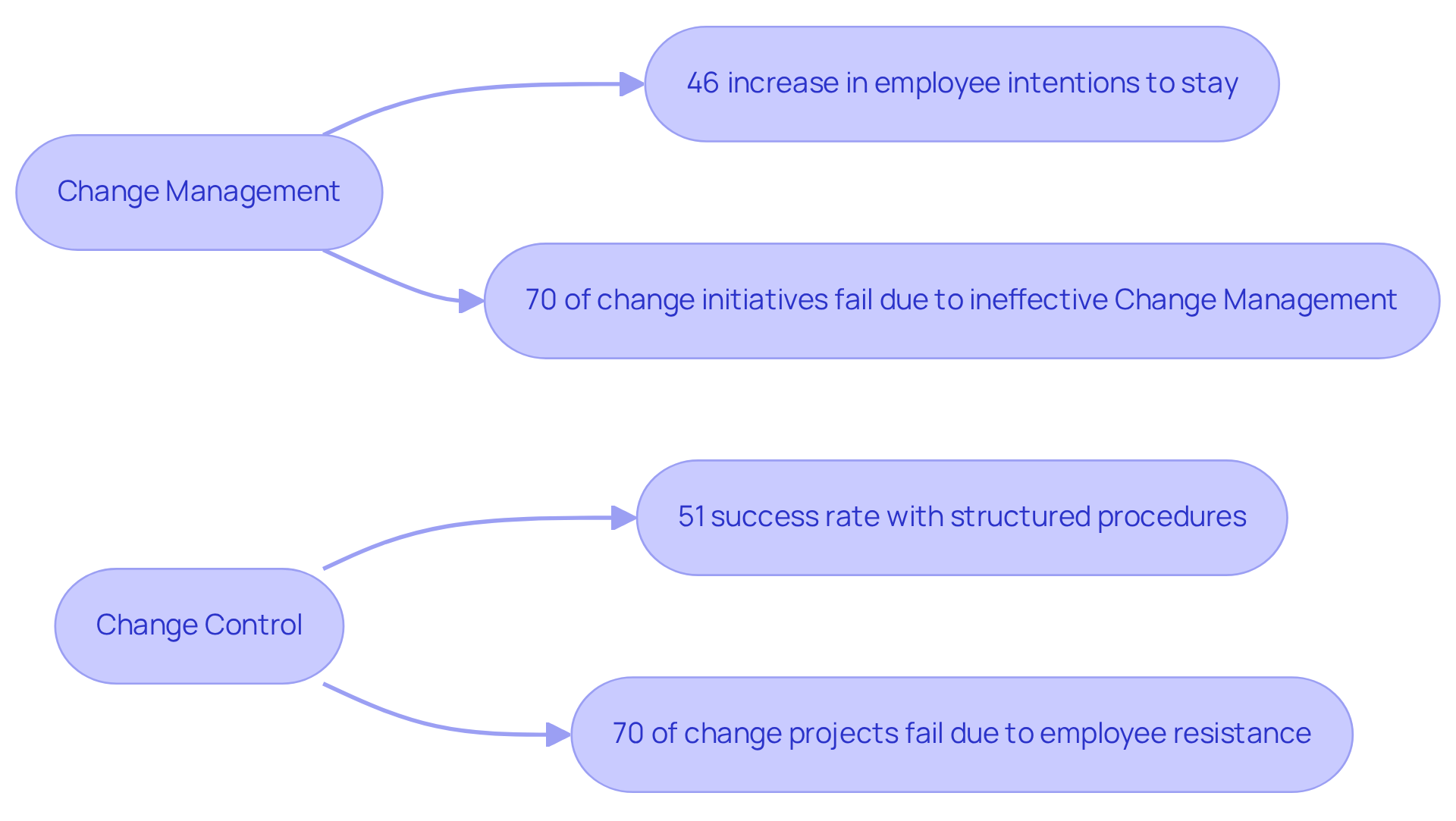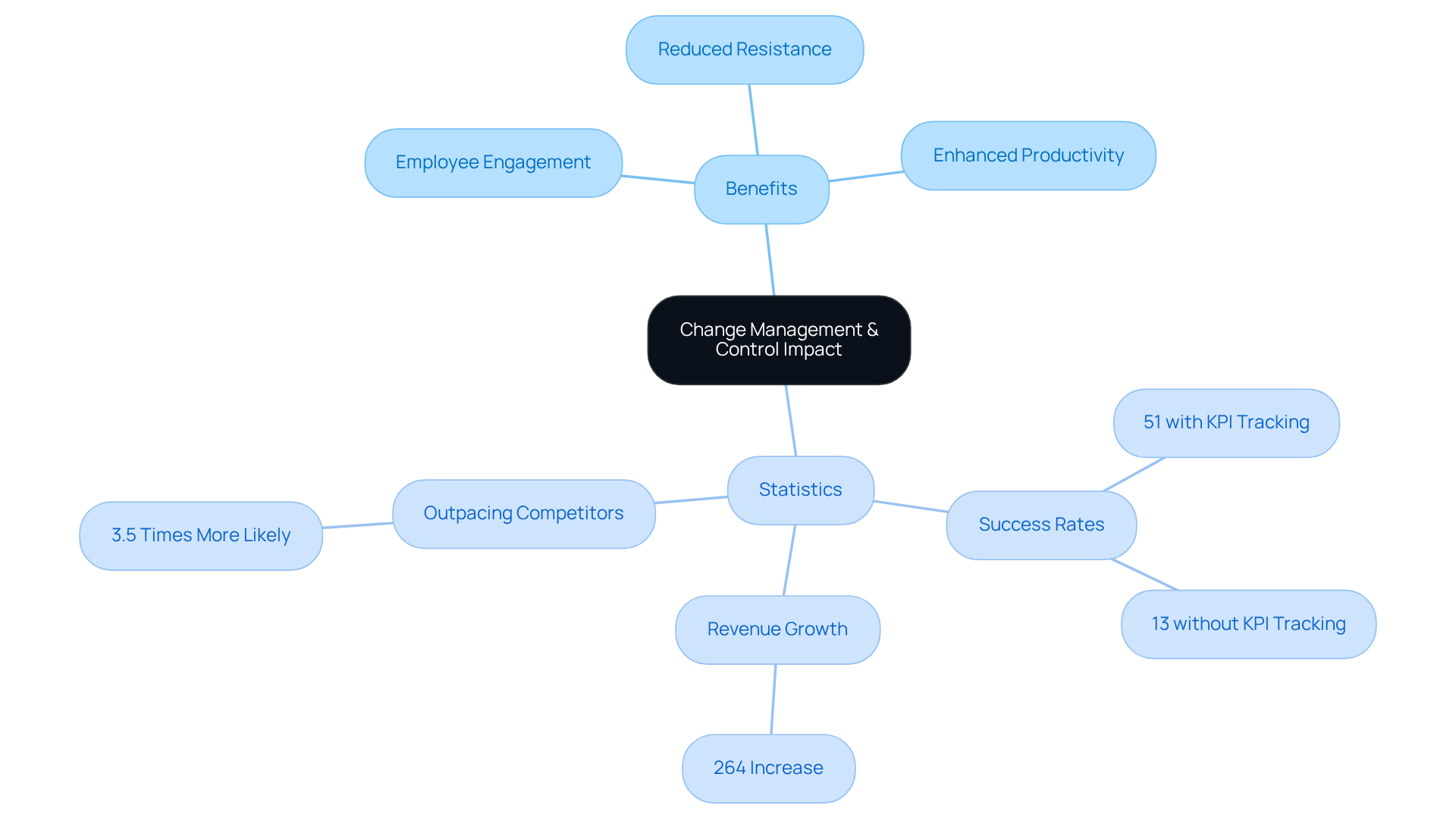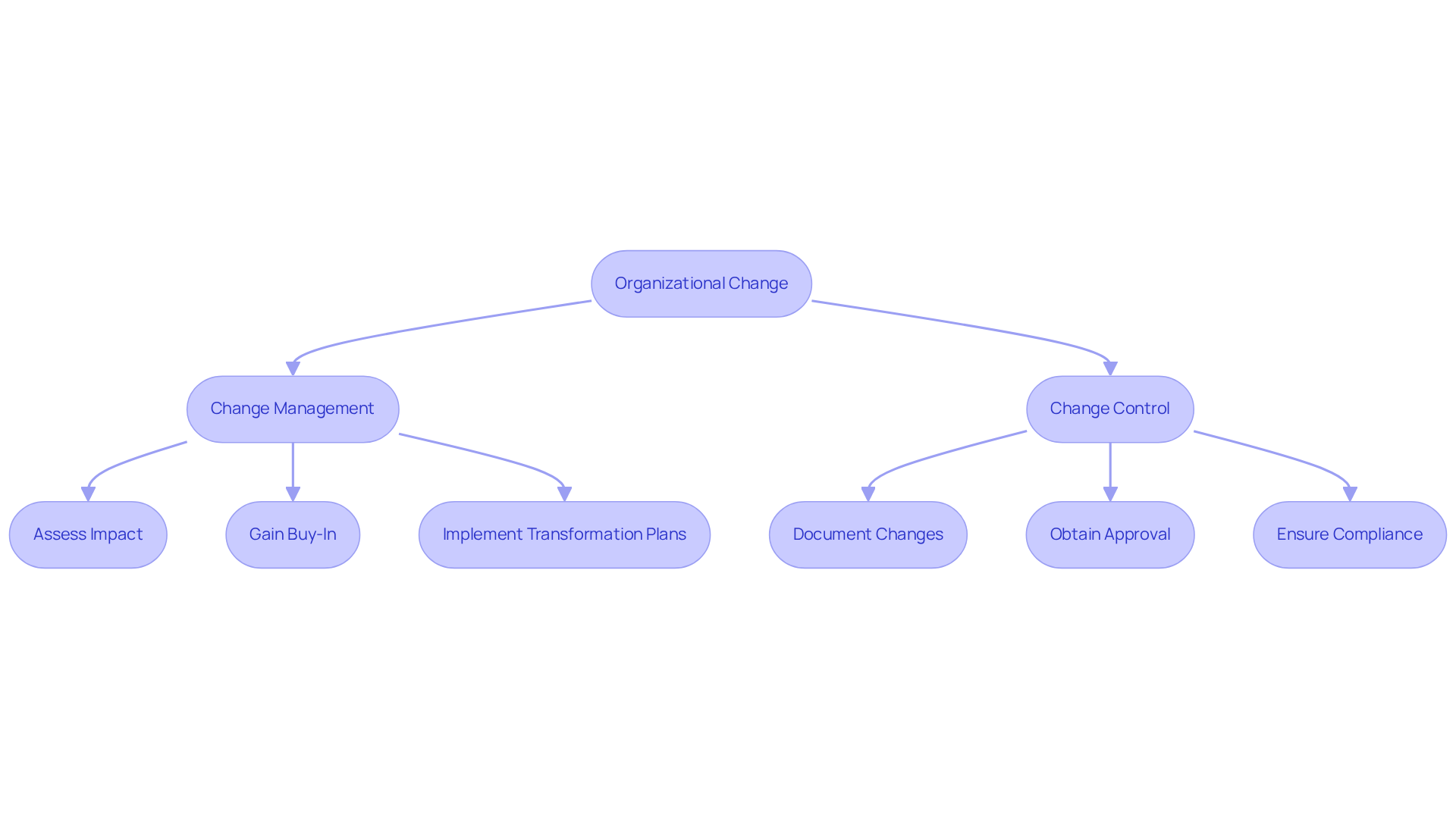
Building a Documentation Culture
|
October 16, 2025
|
Change Management vs Change Control: Key Differences and Impact
Overview
You might be wondering about the differences between change management and change control. Well, here’s the scoop:
- Change management is all about the human and cultural side of organizational transformation.
- Change control zeroes in on the technical and procedural aspects of managing specific changes.
It’s a pretty big distinction! And get this—organizations that embrace effective change management practices see success rates that are off the charts:
- 51% for those with structured procedures,
- compared to just 13% for those flying blind.
This really shows how crucial both approaches are for achieving successful transformation outcomes.
Key Highlights:
- Change management is a systematic method to guide organisations through transformation, focusing on the human side of change.
- Effective transformation oversight can increase employee engagement by 46%, but 70% of initiatives fail due to poor oversight.
- Change control specifically manages changes to systems, processes, or products, ensuring modifications are necessary and beneficial.
- Organisations with structured change control procedures report a 51% success rate in initiatives, compared to 34% for general initiatives.
- Transformation management focuses on the cultural aspects of change, while change control is more technical and documentation-focused.
- 75% of organisations expect an increase in transformation initiatives, highlighting the need for effective oversight.
- Engaging employees in transformation can boost success rates by 30%; projects lacking effective management are eight times less likely to succeed.
- Companies labelled as 'transformation accelerators' experience 264% more revenue growth than those that do not adapt effectively.
- Organisations with robust change management procedures have a 51% success rate, while those without see only 13%.
- Only 31% of employees feel supported during transitions, indicating a need for improved change management processes.
Introduction
You might be wondering about the differences between change management and change control, especially if your organization is navigating the tricky waters of transformation. Understanding these nuances is super important! Change management is all about the human side of things—making sure employees feel engaged and supported during transitions. On the flip side, change control focuses on the technical processes that dictate how changes are made and documented.
With businesses facing more transformation initiatives than ever, the stakes are pretty high: nearly 70% of these efforts fail due to lack of proper oversight. So, how do organizations strike a balance between having structured control and fostering a culture that’s open to change? Exploring this dynamic not only highlights the key differences but also shows just how much these approaches can influence organizational success. Now, let’s dive into what this all means for you and your team!
Define Change Management and Change Control
You might be wondering what oversight really means in the context of transformation. Well, it’s a systematic method that organizations use to guide individuals, groups, and even entire companies from where they are now to where they want to be in the future. This journey involves a mix of tools, techniques, and methodologies that focus on the human side of change, making sure that transitions go smoothly and that the benefits stick around. It’s interesting to note that effective transformation oversight can really amp up employee engagement; organizations that actively involve their staff in these initiatives see a whopping 46% increase in employees' intentions to stick around. But here’s the kicker: 70% of transformation initiatives actually fail due to poor oversight, which highlights just how crucial strong planning and employee involvement are during these transitions.
Now, let’s shift gears and discuss change management vs change control. This is like the technical cousin of change management vs change control, as it focuses specifically on how to manage changes to systems, processes, or products. It’s all about having a methodical approach to assess, document, and authorize any changes before they happen. This ensures that changes are not just necessary but also beneficial, minimizing disruptions and keeping everything running smoothly. For instance, organizations that adopt structured Control procedures report a 51% success rate in their adjustment initiatives, compared to just 34% for general initiatives. That’s a significant difference, right? It really underscores the need for a structured approach to achieve successful outcomes.
So, why is Modification Control so important for organizations? It provides a framework for managing risks associated with changes, ensuring that every modification is carefully evaluated and aligned with the company’s goals. We’ve seen successful Control executions in various businesses, where clear communication and employee involvement have led to smoother transitions and better overall performance. As organizations navigate the complexities of transformation, understanding and effectively using the principles of change management vs change control becomes essential for reaching those desired outcomes. Industry leaders are quick to point out that effective Control of Modifications is key to maintaining operational integrity and ensuring that changes positively impact organizational goals.

Contrast Key Differences Between Change Management and Change Control
You might be wondering about the difference between Transformation Oversight and Transformation Control, particularly when considering [change management vs change control](https://sowflow.io), especially if your organization is going through some changes. Well, here’s the scoop: Transformation Management is all about the bigger picture. It dives into the human and cultural sides of transition, focusing on communication, training, and getting stakeholders involved. The goal? To prepare and support everyone in adapting to new situations. On the flip side, Change Control is more technical. It zeroes in on the specific changes being made, ensuring those modifications are feasible, authorized, and carefully documented.
Now, understanding this distinction is crucial, particularly since nearly 75% of organizations anticipate a rise in transformation initiatives over the next three years. That’s a significant number! Dr. Jeremy Pollack points out that with 70% of these initiatives failing, effective oversight becomes vital. Interestingly, organizations that actively engage their employees in the transformation process see a 30% bump in success rates. That really highlights how important it is to involve everyone to achieve the results you want. On the contrary, projects that struggle with change management vs change control are almost eight times less likely to hit their targets.
Speaking of trends, organizations dubbed 'transformation accelerators' are enjoying a whopping 264% more revenue growth compared to those that don’t adapt as effectively. This really drives home the point that it’s not just about managing the technical aspects of transformation; it’s also about fostering a culture that embraces change. For instance, companies that use open-source strategies in their transformation efforts report a 24% increase in success probability and a 33% reduction in implementation time, with success rates climbing from 34% to 58%—pretty impressive, right?
In summary, while Transition Governance focuses on how individuals and processes adjust to changes, the discussion of change management vs change control emphasizes what changes are made and how they’re executed. Recognizing when to use each approach is key to achieving successful outcomes in today’s fast-paced business world. So, what’s your next step in navigating these transformations?

Examine the Impact of Change Management and Change Control on Organizations
You might be wondering how effective Transition Management can really make a difference. Well, it significantly boosts employee engagement, cuts down on resistance to change, and enhances overall productivity. By putting the human aspect of transformation first, organizations foster a culture of adaptability and resilience—something that's crucial in today’s fast-paced world. On the flip side, effective change management vs change control is key to minimizing risks associated with modifications, ensuring that changes don’t throw a wrench in ongoing operations. This organized approach to assessing and approving changes not only improves compliance but also strengthens quality assurance processes.
Now, let’s dive into how both transition management and control can work hand in hand. When done right, they pave the way for smoother shifts during times of transformation, leading to better organizational performance. For instance, organizations with robust alteration management procedures boast a 51% success rate in transformation initiatives, while those without see a mere 13%. And get this—companies that keep an eye on KPIs during transformation execution also hit that same 51% success rate, showing just how effective systematic methods can be.
Speaking of impressive stats, firms labeled as 'transformation accelerators' enjoy a staggering 264% increase in revenue growth. Plus, those that manage transitions effectively are 3.5 times more likely to outpace their competitors. This really highlights how crucial these frameworks are for organizational success. But here’s a thought: only 31% of employees feel their organization does a good job of preventing them from feeling overwhelmed by transition-related demands. This really underscores the need for effective processes in change management vs change control. So, what do you think? How can your organization step up its game in this area?

Identify Situations for Implementing Change Management vs Change Control
You might be wondering how transformation oversight can really make a difference during big changes in an organization, like mergers, acquisitions, or when new technologies come into play. Well, it turns out that this approach is super important, especially when changes affect employee roles, responsibilities, or the overall culture of the workplace. Research shows that a staggering 70% of transformation initiatives fail because employees resist change and management doesn't back them up. This highlights just how crucial effective Transformation Management is for gaining buy-in and minimizing disruption. So, organizations really need to create, implement, and assess their transformation plans to tackle these challenges head-on. With SowFlow, teams can easily whip up user guides and keep documentation up to date, making sure it’s always accessible and relevant—this is key for supporting employees during transitions.
Now, let’s dive into another aspect: Control over modifications as it relates to change management vs change control. This is especially relevant in environments where technical adjustments happen regularly, like in IT or engineering projects. It’s vital when changes require thorough documentation and approval in the framework of change management vs change control to meet compliance and quality standards. For example, organizations that effectively implement change management vs change control can significantly reduce mistakes and ensure that all changes align with established protocols. By leveraging SowFlow's instant documentation features, companies can streamline their processes of change management vs change control, making it a breeze to manage updates and keep compliance in check. By understanding these contexts, organizations can strategically apply the right process to achieve their goals, ultimately boosting overall operational efficiency.

Conclusion
Navigating transformation can feel like a daunting task, right? Understanding the distinctions between change management and change control is essential for organizations looking to make this journey smoother. Change management is all about the people and culture involved in transitions, ensuring that everyone feels engaged and supported. On the flip side, change control takes a more technical route, focusing on careful assessment and documentation of changes to keep risks at bay and maintain operational integrity. Both of these processes are key to achieving success in today’s fast-paced business world.
Now, let’s talk about why integrating both change management and change control is so important. Effective change management boosts employee engagement and cuts down on resistance, which means higher success rates for your initiatives. Meanwhile, having structured change control procedures in place can significantly enhance compliance and quality assurance, making sure that every modification aligns with your organization’s goals. The stats are pretty clear: organizations that embrace both strategies tend to perform much better, with those transformation accelerators seeing impressive revenue growth.
Given the hurdles that come with transformation initiatives, it’s crucial for companies to take a holistic approach that weaves together both change management and change control. By cultivating a culture that welcomes change and implementing structured processes, businesses can boost their adaptability and resilience. As you gear up for future transformations, prioritizing these frameworks will not only help you mitigate risks but also drive sustainable growth and success. So, what’s the takeaway? Invest in effective change management and control practices to truly unlock the potential of organizational change!
Frequently Asked Questions
What is change management?
Change management is a systematic method that organizations use to guide individuals, groups, and companies through transformation, focusing on tools, techniques, and methodologies that prioritize the human side of change to ensure smooth transitions and lasting benefits.
How does employee involvement affect change management?
Actively involving employees in change initiatives can lead to a 46% increase in their intention to remain with the organization, highlighting the importance of employee engagement in successful transformations.
What is the failure rate of transformation initiatives due to poor oversight?
Approximately 70% of transformation initiatives fail due to poor oversight, emphasizing the need for strong planning and employee involvement during transitions.
What is change control?
Change control is a methodical approach focused on managing changes to systems, processes, or products, ensuring that any changes are assessed, documented, and authorized before implementation to minimize disruptions.
How does structured change control impact success rates?
Organizations that adopt structured change control procedures report a 51% success rate in their adjustment initiatives, compared to a 34% success rate for general initiatives, demonstrating the effectiveness of a structured approach.
Why is change control important for organizations?
Change control provides a framework for managing risks associated with changes, ensuring that modifications are carefully evaluated and aligned with the company’s goals, leading to smoother transitions and improved performance.
What role does communication play in change control?
Clear communication and employee involvement are crucial for successful change control executions, as they contribute to smoother transitions and better overall performance within organizations.
What is the significance of understanding change management and change control?
Understanding and effectively using the principles of change management and change control is essential for organizations to navigate transformation complexities and achieve desired outcomes while maintaining operational integrity.
👍
What others are liking
5 Steps to outline your ideal documentation structure
5 MINS READ
Where to start the your journey of mapping out your ideal documentation structure, aligning it with the very heartbeat of your organization?
Defining a winning level of detail in your process
3 MINS READ
What is too much detail, and what is too little? This article described in that winning level detail about what detail is enough.





